
Career Change to Personal Training: Tips & Advice
How to Change Career to be a Personal Trainer Successfully
Understand What a Career in Personal Training is Going to Give You compared to your existing Role
Before you switch careers to being a Personal Trainer you need to know why you’re doing it, what's causing the push and most importantly what are the pulling factors to a career in this sector.
I have compiled some commonly asked questions that individuals have asked me when considering a career switch to Personal Training and my answers based on my own personal experience both as a Fitness Careers Advisor and as a PT that has been qualified for 17 years.
Does Personal Training have a high Job Satisfaction?

In a nutshell, yes, according to Career Explorer which conducted a study of how “happy” personal trainers are, they found that Personal Trainer ranked in the 79th percentile of all career choices for job satisfaction.
It is extremely rewarding to help people and is a job choice that feels very purposeful in nature, especially if you help a client that you have genuinely helped to reform their life choices and how they feel about themselves.
This is very difficult to emulate in other career paths.
What is it like working as a PT in a Gym?
If you’re currently working in an environment that you do not enjoy or worse, it’s negatively impacts your mental wellbeing, changing your career to be a PT might be a nice switch.
Working at a commercial gym is vibrant with a fantastic social aspect as you get to work with like minded people, but also engage with members from diverse backgrounds on a day to day basis, which keeps work interesting and fun.
What is it like working as a Freelance PT?
This varies slightly based on which freelance route you opt for, which we will discuss later in this article, but, one commonality across all forms is that you must enjoy times when you work independently on your admin, bookkeeping, marketing and process management.
You still get to interact with clients in a similar way to a PT in a gym, but your success is determined exclusively by you and the effort level you put into tasks away from just delivering Personal Training sessions. For some people this is great as they can build their own brand, for others, sticking to the gym floor might be more appropriate
How much will I earn as a PT?

Employed
If you opt to work in a gym on a full time basis, the typical annual basic salary outside of London is £24,000 and £28,000 in London.
You normally get commission based on the revenue you generate from delivering personal training back to you in your monthly pay slip, meaning the average OTE (on top of earnings) outside of London is £34,000 and £39,000 in London.
This does vary based on the brand that you work for and the personal training model that they adopt. Some gyms elect to just offer a set number of hours and simply just pay you an hourly rate for those set number of hours with an average hourly rate outside of London of £17 per hour and £20 per hour in London.
Freelance
Some established freelance trainers can earn comfortably over six figures and in rare circumstances even seven figures, but these are normally individuals that have grown their business to the point where they either have their own venue or a decent number of staff members operating underneath them.
There is no set defined number of how much you will earn as a freelance PT, but you give you some indications based on hourly rates, a Freelance PT will typically earn around £35 per hour outside of London and £40 an hour in London.
Explore Jobs in Personal Training
Find your prefect job as a Personal Trainer with Active Careers. Our niche is "Getting your Career in Shape"
Skills & Traits that help you Change Career to Personal Training and be a Success

You might already have the fundamental skills needed to be a Personal Trainer that you have developed through past and current job roles and not know it.
You might also be at the other end of the spectrum and think you already know what it takes to switch careers to Personal Training, but see below some skills that you might have not considered that I feel are really relevant for the role:
A) Ability to Meet Deadlines
Yes, PTs are always under pressure to meet deadlines especially if you have a large client base to manage. You will have to deliver programmes on time, nutrition plans, progress reports and prepare for client consultations.
B) Creativity
You also need a pinch of creativity as a PT to keep training innovative, varied and exciting for your clients, but also this skill is very relevant in how you market yourself and through which means.
C) Punctuality
If you’re a stickler for time keeping, that will hold you in good stead as a PT as being reliable and punctual is a mandatory requirement. Clients will not tolerate you being late for sessions or consultations and they will simply replace you with another trainer that is more professional.
D) Relationship Building
This is the most important skill all successful Personal Trainers have in common, you must be able to build relationships with people from all types of backgrounds.
This job is one to one and you spend a lot of time with individuals and often clients pick PTs based on how you interact with one another more than the quality of your services.
E) Ambition and drive
More of a needed trait than a skill, but you need to be someone who wants to develop, learn on the job and strive towards delivering both excellent customer service and business growth.
F) Time Management
In both freelance and employed personal training roles, you will have to manage your own time and your ability to do so will determine a large part of your success, especially when you have to balance consultations, programme writing, sessions, research, marketing and sales.
You don’t need to have all these skills and traits to be a successful PT (I certainly didn’t), but you need to acknowledge them and work towards improving your weaknesses.
G) Sales & Marketing
Arguably the most important skill is sales and marketing, especially if you go down a freelance route. If you can supply your business with a stream of high quality leads and are able to convert them into new clients, that is over half the battle.
But don't stress if this is something you have no experience in, as I had no experience in this ether as unlike some skills it's super easy to learn as you go.
Research & Plan your Personal training Career Change Before Jumping Straight in

The best piece of advice I can give you is to research the different career avenues you have available to you before getting qualified and committing to this career path.
Most Personal Trainers that are newly qualified have no idea how they can use their qualification or what direction(s) they can take their career.
But I'm going to break these down the major ones here for you:
Factors to Consider when planning to change career to that of a Personal Trainer:
Where and how you deliver Personal Training
What niches are you going to target
What is your pricing point
What services are you going to offer
Plan your Transition around your current circumstances
Where & How you're Planning to deliver Personal Training

A very key element when changing careers to Personal Training is to establish where and how you’re going to deliver your service.
If you’re electing to work in a gym, you're going to be delivering sessions using the gym's facilities.
Full-time Salaried Position in a Gym
This is exactly as it sounds, you will be paid a set annual salary where you deliver fitness and personal training related services on behalf of the gym or studio.
Most gyms that employ trainers this way either offer commission on client revenue generated back to the trainers on top of their basic wage or they simply just pay you per hour on the time you have in your contract.
Best Suited for: This model is ideal for those who are newly qualified or someone who lacks confidence as you get more time to hone your craft, learn whilst earning a good income and you get lots of support from the gym as they are investing in you as they pay your salary.
Freelance in a Gym
You can work at a variety of gyms in a freelance capacity where you pay rent to the gym in exchange for harnessing the gym membership base and facilities to deliver personal training.
This is now the most common way gyms operate, especially budget gyms and is relatively high risk, high reward as you only get paid when you acquire clients but you do keep 100% of the revenue earned.
Best Suited for: This personal training model is best suited to someone who want to grow their own business, is competent at sales and has past experience working independently.
Part Salaried and Part Freelance

The “Part Salaried and Part Freelance”, is where you get a contract of a set number of paid hours, normally between 10-15 hours per week depending on the brand, where you deliver services the gym offers such as classes and inductions.
Outside of those set hours, you can then commit as many hours as you choose to grow your freelance business from the gym. This tries to give you the best of both worlds,
Best Suited for: This is my personal favourite route to market as it gives you the opportunity to grow a freelance business whilst providing you some job security from the paid hours you receive.
Personal Train Outdoors
You can Personal Train clients outdoors, using parks, playgrounds, beaches and fields.
Of course the weather plays a key role in what outdoor services you can offer, but you can also have seasonal based services that only apply in the warmer months.
See below how Clapham based Personal Trainer Jorge Rojo has built his entire business using the great outdoors, running both one to one sessions and fitness bootcamps.:

Offer Online Personal Training
Are you going to opt down the online route and administer programmes and nutrition plans digitally for clients.
You can deliver online PT in a few different ways such as asking clients to record themselves and then send their videos in and provide constructive feedback to them over or email or even watch them train live once a week and provide motivation from the comfort of your own home.
See here how Personal Trainer David Kingsbury has set-up his online PT business, offering customised plans that largely focus on fat loss and round the clock support:
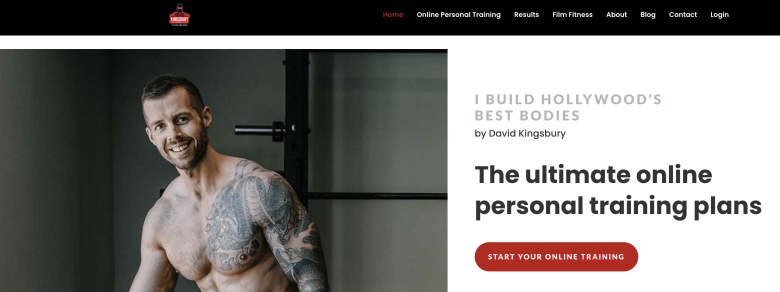
Home Personal Training
You can deliver personal training in clients homes, where you travel round your local area from client to client or even create a hub within your own home for clients to come to you.
See here how Sheffield based Personal Training company The Coaching Club have set-up a home personal training service to their business:
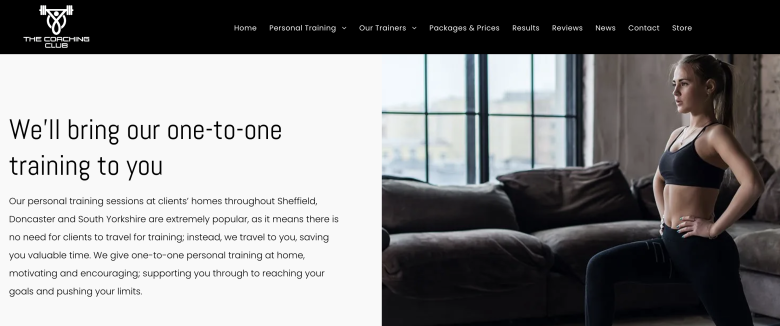
Grouped Personal Training
You could offer a grouped Personal Training service where clients still work on a custoimsied programme tailored to their training aims, but you PT them in small groups, normally between 2-6 people.
This helps you drive up your hourly rate, and the client is happy as they normally get a reduction in cost for having their session split with other clients.
See here how Nxtep Personal Training is offering grouped PT sessions to their clients in Knutsford, Cheshire:
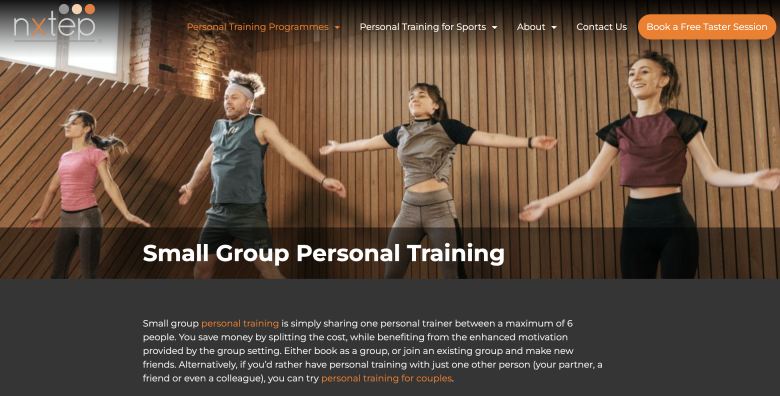
Combining Freelance Routes
You can widen your income streams and appeal by offering multiple ways of offering Personal training by combining one or more of the above together.
What Niches are you Going to Target When you Switch Careers to Personal Training?

Many trainers misunderstand what a niche in business terms actually is.
A niche is a particular aspect or demographic that you’re looking to appeal to within a larger market.
The reason this is important to understand, is that many PTs misinterpret that it's part of a larger market and that you still want to appeal to clients with more stereotypical goals as well as having specialisms or services that other trainers in your vicinity do not possess or provide services that they don’t offer.
See some examples of potential niches you could target or you can focus on multiple ones if you wish to:
Age Demographic - You could target your training towards fitness activities for kids or the elderly or both.
Pre and Post Natal - You can undertake a pre and post natal qualification and start working with pregnant women and those who are trying to get back into fitness post birth.
Mental Health & Lifestyle Coaching - You can offer mental health coaching to help clients that want a more holistic approach or struggle with day to day mental health.
Competition Preparation - You can target competitive athletes, both amateur and professional. Whether you want to target bodybuilders preparing for a bodybuilding show through to those looking for help with a training and preparation for their respective sport.
Yoga or Pilates - You could provide yoga or Pilates classes either one to one or in a group based format.
Luxury market - You could aim your training towards high paying clientele through offering high levels of service and support such as providing towels and drinks for all your client's sessions.
Corporate Wellness - You could gear your services towards corporate companies to help them boost physical wellness and productivity ioj the workplace or create fitness based team building days.
What Services are you Going to Offer within your Packages When you Change Careers to be a PT?

A key element to consider when changing careers to be a PT, is deciding on which services you’re going to offer clients and how those services operate.
Here are some ideas for you to consider when planning how to set-up as a PT:
Are you going to include nutrition plans?
Are these going to be included within your clients packages or are you going to charge separately for these? How often can your client get their nutrition plan re-visited?
What levels of support are you going to offer clients?
How are you going to deliver support to your clients outside of the gym and through which mediums? Are you going to offer email support, have zoom meetings, have a newsletter or even a whatsapp group.
Are you Planning on delivering any grouped sessions?
You might want to add value by offering a free grouped PT session once per month or have this as an extra service that clients can pay for separately.
Are you going to Include Fitness tests?
You can offer body fat analysis tests, postural tests, fitness tests or flexibility tests for clients to statistically evaluate the difference at set periodised points within their programme.
Are there any extra amenities you're going to include?
You can also add value to your clients by offering clients a variety of amenities, such as including a towel for them when they arrive, free drink or even pre and post workout supplements.
Are you planning to use any Software?
What software (if any) are your clients going to access? You might use software to allow clients to access their programme via a white labeled piece of software or track their nutritional intake via a customized app.
Are you Planning to include any Social Events?
Many trainers add value to their clients by running social events like hikes, barbecues, nights out or fitness charity events.
Will you have a Loyalty Scheme for Clients?
You might want to offer a loyalty scheme where clients can win or gain benefits the longer they stay with you or for hitting particular goals.
You need to plan your Pricing and Packages Before you Start Personal Training

You need to carefully think about your pricing points and the structure of your packages against the niches you have established and the levels of service you want to include.
The more niche or value you add, the more you can charge for your services.
But getting your pricing point right is super important as once you set a price and gain clients it can be very difficult to change without haemorrhaging income.
Where many new trainers go wrong is two fold:
Charging too Little
You might have thought that it would be the opposite problem of charging too much, but the reality is that new trainers tend to take the logic of “I’m new to this and thus I should charge less”.
This notion causes you problems later as it’s then very challenging to tell clients your now going to charge them more, but the other issue is that many clients firstly don't know your new to Personal Training and experience does not equal your value.
Not Setting up PT Packages Optimally
Trainers new to the industry tend to adopt bad practices of selling PT sessions in blocks of 8, 10 or 12 weeks as opposed to the more optimal way of using a subscription based model.
The subscription model will massively help you keep clients in the long term as opposed to selling sessions in blocks where you have to continuously re-sell to your existing client base.
See a good example here of the subscription based model being used by Coventry based Personal Trainer Dean Clarke:
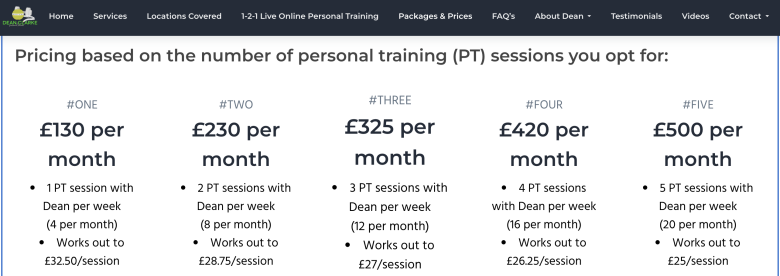
Notice how this is charged per month and has no defined end date? See also that he is rewarding his clients that opt for the higher end packages by reducing the per hour rate.
How to Price Your Personal Training Services When Switching Careers
1) Check how much your competitors charge and what value they are including to justify that cost.
2) Decide how many packages you want and if there is is a difference in service level you're providing for different tiers. For example, you could include more value on your higher end packages.
3) Calculate your monthly overheads or overheads per client against the service you are deciding to provide so you know how much profit you will make per client acquisition.
4) Price higher than you think and adjust later if you need to.
Plan your Transition into Personal Training: Full-time vs Part-time
You need to evaluate how you’re planning to change careers to Personal Training and have an idea of the strategy you’re going to deploy to get your business off the ground.
You need to weigh up if you’re going to make the switch to Personal Training gradually around your current work or bite the bullet and dive straight in.
Below I have outlined the pros and cons of each option, but there is no “right answer”, it depends on you as an individual, how risk averse you are, your drive, both to leave your existing role and to be successful within this industry
Switching Right Away to be Employed Full Time or Part Time in a Gym

PROS:
You will get a guaranteed stable Income that operates like all other jobs from working in a gym within a full-time salaried role.
You will be entitled to holiday pay and have employee benefits so that you get paid whilst on annual leave, leaving you less stressed and more secure.
You can switch careers to Personal Training instantly without any financial concerns or worries about getting clients and generating income.
The types of employers that hire personal trainers full-time have an avid interest in your professional development as they are paying your salary and therefore provide more help, support and mentoring.
A salaried position comes with less pressure by contrast to other personal training routes to get clients and build a business as you always have the basic salary to fall back on.
There are less responsibilities associated with a salaried role as you don't need to focus on the business side of being a PT, such as marketing your services, branding or operations.
CONS:
Both part-time and Full-time salaried roles are in short supply within the industry and thus are highly competitive roles to apply for. Additionally, only certain types of gyms offer this type of role, meaning you may have to travel further than for other roles.
You earning potential is capped as you either are restricted by the number of hours that you can work or you're giving most of your client generated revenue to the gym.
The working hours can be very rigid and you can find yourself working weekends, very early mornings and late evenings.
Freelance Part-Time Around your Existing Role

PROS:
This is a good idea for many aspiring trainers as you maintain the financial stability your current role provides you with whilst you start building up your client base.
You can learn the ins and outs of being a good Personal Trainer without the pressure of needing to get clients right away.
You start developing your own freelance brand and build up a foundation client base ready for when you want to take the leap full-time.
CONS:
Naturally this is going to increase your working hours on top of your main job, which can cause burnout and stress. Additionally, clients communicate with you outside of sessions and you may struggle to find time to get back to them in a professional and prompt manner.
As you still have a full-time position, there is naturally only a limited amount of time slots for clients to actually book in with you and they might want times that conflict with your existing schedule.
Going into any freelance route means that you're on your own. You are going to have to learn the business, marketing, lead generation and the fundamentals of Personal Training off your own back.
Freelance PT Business (Full-Time)

PROS:
As a freelance PT you decide your working hours, how often you work, when you work, who you work with and everything in-between.
You get to build and develop your own brand that you can customise in a way that you deem fit.
You're not can take holidays whenever you choose and take as many holidays as you want without asking anyone for approval.
The earning potential is quite literally uncapped as unlike working in a gym on a salaried basis, you're not giving any revenue back to the gym.
You get good tax relief and benefits as a self-employed PT when set-up as an LTD business or sole trader.
You can progress your career and hire staff or other trainers to do the work fro you, whilst you scale the business, enhancing your earnings or enjoy more leisure time.
CONS:
A major con for any independent freelance Trainers is that you get no paid annual leave.
When making the switch to freelance Personal Training, you start with no clients or income and it takes time to build a client base up.
As you start with no clients, but still have outgoings to think about, this increases the pressure and stress on you to get clients and start generating an income.
There is no guidance, support or manager to help you improve your skills set or teach you how to be successful.
Most freelance trainers require some form of capital to help them set-up things such as their website, advertising, branding, legal forms and software.
It can actually get lonely and you feel isolated at times when being your own boss.
Choose the Best Way To Qualify for Your Current Lifestyle
In order to qualify as a Personal Trainer in the UK, you need to complete at minimum a Level 2 Gym Instructing qualification and a Level 3 certificate in Personal Training, which when completed conjointly is a Personal Trinign diploma.
In order to change careers to Personal training successfully ensure that the qualification is both Ofqual Regulated and the college or training provider you learn via is CIMSPA endorsed.
CIMSPA act as an independent accreditor who training providers within the health and fitness sector seek endorsement from as a stamp of quality to their training.
You can search CIMSPA partner directory here to search CIMSPA endorsed training courses, but also be on the look out for the CIMSPA logo on companies websites:
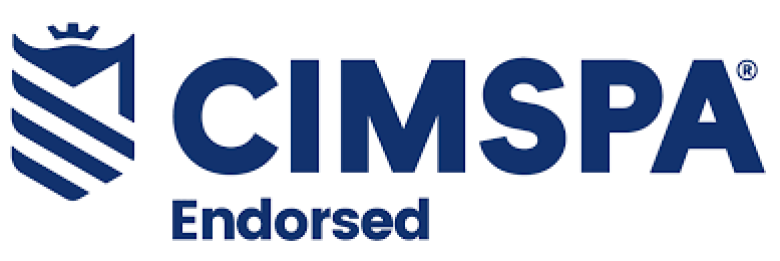
Choosing the method of study that suits your working situation & Lifestyle

When transitioning to be a Personal Trainer, you should evaluate which learning method and company is going to suit both how you learn best as an individual versus how it is going to fit into your existing work and social life.
Study via Online or Distance learning
Choosing to learn online is great if you have good intrinsic motivation to get qualified, have strong academic knowledge or knowledge obtained through similar qualifications like BTECs or university degrees in sports related fields.
This learning style also is perfect if you're currently working full-time hours and looking to qualify at the same time as sustaining your current job.
PRO TIP: Look at how much distance support is available and when that support is actually accessible. It's no good if you work Monday-Friday, 9-5pm and they shut at 5pm and close on the weekends as you will never actually access that support.
Part-time / Blended Learning
Most Training providers offer some form of either blended learning or part-time courses.
Blended learning is where you study through a combination of home study with face-to-face support, whilst part-time courses tend to be more rigid and have set classroom dates and times normally situated on evenings or weekends.
This learning style also helps if you’re working full-time, but you might be better off opting for the online version if classes clash with work or family life.
PRO TIP: Find out from the relevant training provider where your nearest venue is, how much face to face contact time you get and how many people are in each practical sessions as this can impact your learning experience.
Full-Time / Intensive Learning
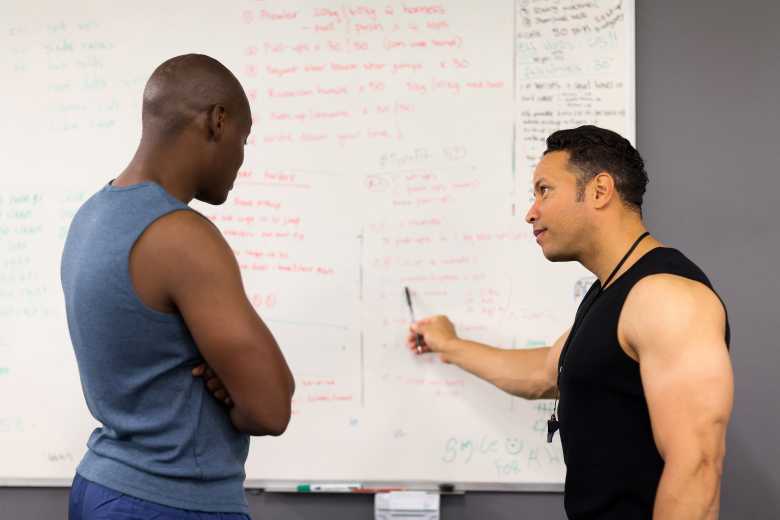
Full-time courses work in the same fashion as part-time courses where you will learn in small groups both on the gym floor and in a classroom setting, but are traditionally delivered during the week on a Monday - Friday basis, normally between 4-6 weeks consecutively.
This learning method is great if you can get a number of weeks off work, have been made redundant or are in between jobs right now.
PRO TIP: Find out how many people you will be learning the course with as if the training provider utilises large groups, this can be detrimental to your learning experience as you won;t be able to get much individualised help from the course tutor.
Study at College
Yes you can go to college to complete your qualifications, where you can study for free if you are aged between 16 and 23. Colleges provide great learning environments and high quality teaching, however if you're over the age of 23 you will have to pay the course fees and it can take up to two years to fully qualify as the course has to be taught against the academic year.
PRO TIP: Academic school years commence in September, thus colleges only onboard new cohorts with this date in mind. If you afre in a hurry to get qualified, going with a private provider would be a much better option for you.
Apprenticeship
You can learn and earn via an apprenticeship which will take around 15 months on average to complete depdning on how quickly you progress with assignments. You can hone your craft whilst learning on the job and get real hands on experience of the role before qualifying to ensure its the right career path for you.
PRO TIP: Do note, like jobs, not all apprenticeship are equal, make sure to review the companies employee reviews by using platforms like Glassdoor, as well as thoroughly reading their job description and responsibilities.
Funding Your Career Change to Personal Training
There are several ways that you can fund your career change to personal training and make that switch as you're working.
0% Interest Payment Plans
Most Training Providers allow you to spread the costs of the course on a 0% interest basis, normally between 1-2 years either through the provider’s finance company or they may have in-house payment plans. Ideal if you have a low income, lack of savings or simply don't want to part with a large sum of money in one swoop.
PRO TIP: Ask the training provider directly if they charge interest as some hide this information in their terms of service.
Pay In Full
Of course you can pay the course off in full if you choose to, especially if you’re not looking to add an extra direct debit to your current outgoings.
PRO TIP: Most providers will offer an incentive if you pay in full for the course as opposed to going via the payment plan, which can range from 10-20% off the course price.
Advanced Learner Loan
Another popular route is to use the advanced learner loan scheme, which is a government scheme to help people finance retraining, where you pay directly out of your salary once you pro-rata earn over a certain amount each month. The advanced learner loan does apply interest rates once you start paying the course fees back.
PRO TIP: If you already earn over the £27,000 per year threshold you will start paying the course fees back immediately and many providers masquerade the advanced learner loan as "free", which is not the case.
Search Thousands of Personal Training Roles
You can search thousands of Personal Training jobs near you with Active Careers
Freelance Personal Trainer Checklist When Starting A Freelance Business

If you're planning to work in a gym, you won't need to do any of the following steps and you can skip this quick chapter.
If you're planning on going down the freelance route though, you will need to do the following five actions in order to operate in the UK:
1) Register with Companies House
Register your business with companies house as either a sole trader or a limited company. I would seek advice from a credible accountancy firm before doing this as their are pros and cons to both routes depending on what is best for and your business.
2) Open a Business Bank Account
You're going to need a business bank account when switching to being a PT to separate out your personal from your business finances.
PRO TIP: Try and get one that offers 18 months to two years free banking from a large, reputable bank.
3) Get Your Business Insured
You will need insurance to operate as a Personal Trainer, that protects your earnings, equipment from damages (if needed) and you from any claims made against you.
PRO TIP: One of the most cost effective insurance providers for Personal Trainers is Insure4sport.
4) Bookkeeping
Log and record every financial incoming and outgoing for tax purposes. This is essential for any business.
PRO TIP: You can just log this using a Microsoft Excel sheet when you first start, but you might need a specific bookkeeping piece of software when your business starts to grow.
Plan How to Get your First Personal Training Clients
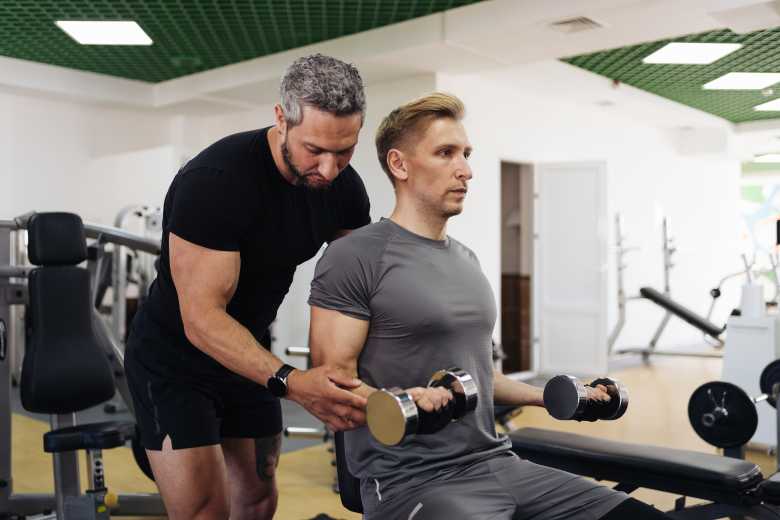
Now that you're qualified, you can either start applying for Personal Training jobs here if you want to start your journey in in a gym or studio.
you need to focus on getting your first clients as a Personal Trainer, whether you're working full-time in a gym or have opted to go down a freelance route.
Have a Plan to Promote, Market and Sell Your Services on a Budget
When you change career to be Personal Trainer, you might not initially have much budget to start advertising here there and everywhere.
But, you do need a plan of action on hiw you're going to repeatedly get fresh enquiries into your business.
There a loads of ways you can get your first Personal Training clients without paying huge advertisement fees that will help you change career into Personal Training:
1) Use Freelance Platforms
You can find specific freelance platforms that allow you to advertise your Personal Training services without any up front costs.
Most of these platforms make money from when a client actually purchases your services and they take a small percentage of the fee.
Take a look at the Personal Trainers doing this right here on Superprof:
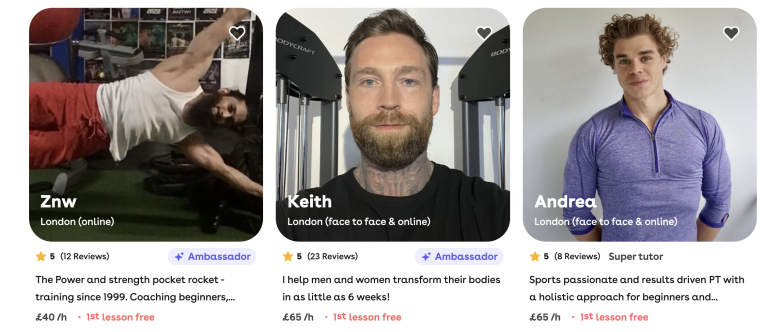
You can also use other similar websites like Bark.com who only charge you once you get an enquiry about your services:
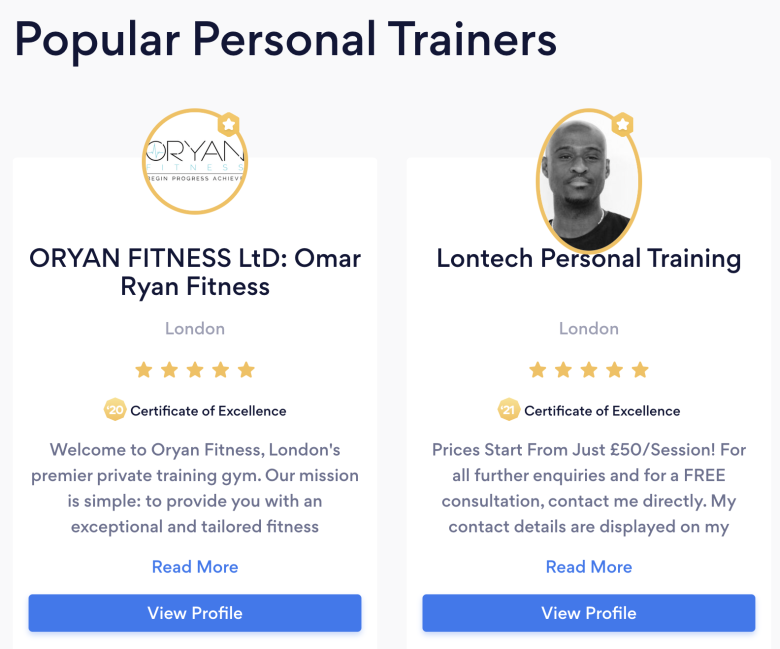
2) Set-Up Your Bing & Google Business Profile
Setting up your Bing and Google Business Profile is essential for every business regardless of what industry they specialise in and you must do the same!.....The best part is that it takes 10 minutes and they are both free!
See below the results when I type into Google "Personal Trainer Exeter", which is what a potential client might do to try and find a PT in the Exeter vicinity:
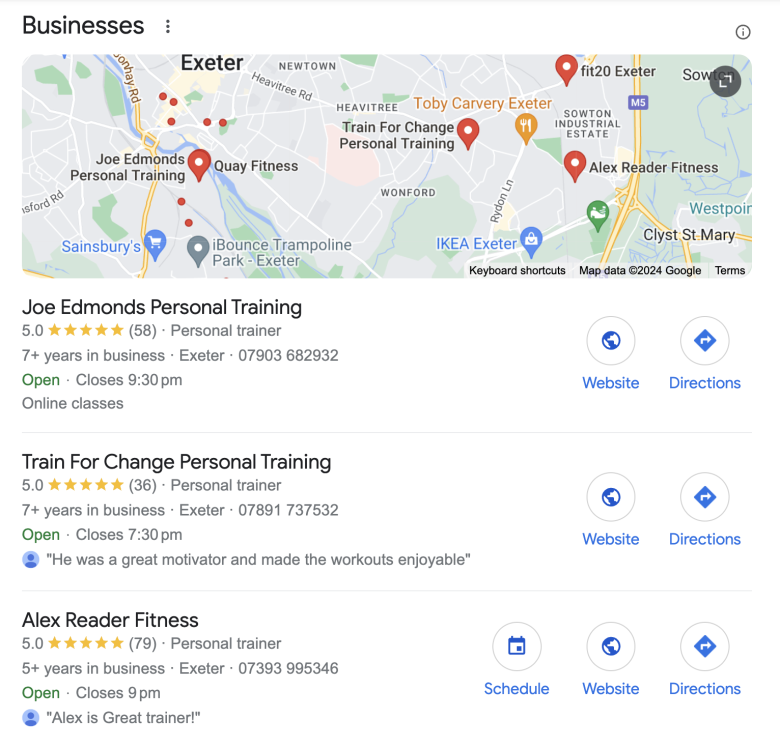
You can find out how to set-up your Google Business Profile here.
3) Use Voucher Code Websites
If you have no advertisement budget, using voucher code sites gives you free advertisement for your services. Voucher code sites work in a similar fashion to the freelance platforms I mentioned before where they will take a cut of your profits for very client you acquire.
Voucher sites are used by millions of people across the UK looking to make a saving, so you will have to put on an offer that allows you still to make a good margin but also makes your offer stand out against other Personal Trainers.
See below just some of the Personal Trainees using Groupon to advertise their services:

Once you get to this point and have acquired some new clients you should re-asses how you're going to scale your business further and where you want to take your career.
Find Personal Training Jobs here
Find your first job in Personal Training with Active's Careers. The Uk's only Jobs board for Personal Trainers.

